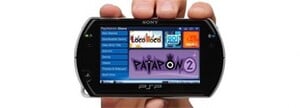
Ever since E3 2009, we've been approached by a number of people all hampered with the question, "Why should I buy the PSP Go?" In this piece, we'll look at the reasons for choosing the PSP Go over its older brother the PSP-3000, and discuss the platforms strengths and possible weaknesses.
The Playstation Portable was named just that for a reason. It was designed as a portable platform, for portable playing sessions in remote places. Sadly, it's never quite felt like that. The clunky feel of the original PSP and invisible screen in general lighting made it impossible to play the system outside, and while the PSP-3000 went someway to fix those problems, the overall design of the system hampered its portability. Cue: the PSP Go.
The PSP Go is 43% lighter than the original PSP (lighter in fact than an iPhone) and significantly smaller in width and thickness due to a slightly reduced screen and new slide functionality. That makes the system perfect for pocket use; where like any good portable equipment you cannot feel its presence. The original PSP design often led to bulk in the pocket restricting its portability.
That is coupled with the fact that the original breed of PSPs ran on UMD. UMDs were Sony's grand development for the portable space - a small optical disc that could store up to 1.8GB of data. Unfortunately for Sony, the format received a large deal of criticism from developers due to the hackable nature of the format and the lack of writers/blank media.
For the consumer, UMD presented its own problems. Not only does the UMD format increase load time (due to the number of internal moving parts) but it also means fumbling to change game when travelling. Again we return to the portable aspect of the system. With the PSP Go running from data stored on the system's memory, content can easily be switched at the speed of navigating to the relevant option via the XMB. No bag space will be required to store the cases of alternative UMDs; all content is on board the pocket sized system.
The Playstation Store
It's genuinely an innovative move to make the PSP Go a digital download only system. A move probably forced by Apple's iPhone, but still a bold one at that. We appreciate some people like to have their game collection on display and if you are one of those people, then we probably don't recommend the PSP Go. However, there are advantages to downloading content.
It's worth remembering that the PSP-3000 is perfectly capable of running downloadable games too. The latest firmware updates provide access to the Playstation Store. Still, you'll be doing it with significantly less memory available. The PSP-3000 accepts one Sony Pro-Duo memory card which can store up to 16GB at the moment; the PSP Go comes with that much space on board and support for a Memory Stick Micro - offering the possibility to store at least 32GB in total. While we would have appreciated more on-board space, that's enough for at least 20 games; all of which will be accessible from the XMB.
It's also worth nothing that where-ever there is a wireless Internet connection, you'll be able to sync your PSP up to the Playstation Store and download content. Imagine train trips to university, where you buy and download your latest game during a lecture and play it on the way home on the train. It's true portable gaming, only hindered by the requirement of a wireless Internet connection. Perhaps a missed opportunity on Sony's part to go the full hog and introduce mobile phone networking, but a sure step in the right direction towards making the PSP a real portable system.
Aesthetics & Feel
If you're still undecided about whether this system is for you, perhaps it's best to consider the aesthetics and feel of the system. The PSP Go launches on October 1st and makes some significant changes to the original face layout of the Playstation Portable. The analogue nub is now placed more in line with the DualShock (to the right of the D-Pad) and the system as a whole keeps the hands closer together due to the screen's alternative placement.
It may be worthwhile holding out on your purchasing decision to spend some time with both of the systems and make your choice that way. After all, part of the gaming experience is feeling comfortable with the controls and there are signicant changes between the faces of the PSP Go and PSP-3000.
Pros:
To summarise, let's discuss the pros and cons of the new PSP Go system.
- Greater portability.
- Smaller size, reduced weight.
- Bigger potential space cache for more games.
- Shorter loading times/less mechanical parts (due to lack of UMD).
Cons:
- Potential redundancy of content for those who have already invested in a UMD collection.
- High price tag.
- Space cache may be quickly absorbed by avid users.
- Smaller screen.
With Sony's pledge to support both the PSP Go and PSP-3000, it honestly doesn't feel like choosing is a burgeoning choice. Naturally as a consumer you'll want to get the system that offers the best value for money, but with the PSP Go and PSP-3000 clearly being marketed at slightly different people, at the end of the day, like most things, the purchase decision will come down to a matter of taste and preference.
Where do you stand?
Comments 0
Wow, no comments yet... why not be the first?
Leave A Comment
Hold on there, you need to login to post a comment...